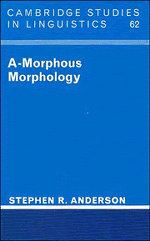Book contents
- Frontmatter
- Contents
- Acknowledgments
- Introduction
- 1 The study of word structure
- 2 Why have a morphology at all?
- 3 Is morphology really about morphemes?
- 4 The interaction of morphology and syntax
- 5 The theory of inflection
- 6 Some complex inflectional systems
- 7 Morphology in the lexicon: derivation
- 8 Clitics are phrasal affixes
- 9 The relation of morphology to phonology
- 10 How much structure do words have?
- 11 Composites: words with internal structure
- 12 Morphology and the typology of languages
- 13 Morphological change
- 14 Morphology as a computational problem
- References
- Index
11 - Composites: words with internal structure
Published online by Cambridge University Press: 10 January 2011
- Frontmatter
- Contents
- Acknowledgments
- Introduction
- 1 The study of word structure
- 2 Why have a morphology at all?
- 3 Is morphology really about morphemes?
- 4 The interaction of morphology and syntax
- 5 The theory of inflection
- 6 Some complex inflectional systems
- 7 Morphology in the lexicon: derivation
- 8 Clitics are phrasal affixes
- 9 The relation of morphology to phonology
- 10 How much structure do words have?
- 11 Composites: words with internal structure
- 12 Morphology and the typology of languages
- 13 Morphological change
- 14 Morphology as a computational problem
- References
- Index
Summary
Of the several types of word formation recognized in the ‘classical’ morphological tradition, one important one remains to be treated here: the formation of compounds. In its traditional sense, compounding differs from derivation and inflection in quite a straightforward way. It consists in the combination of (two or more) existing words into a new word, while derivation (as well as inflection) consists in the application of a Word Formation Rule to a single existing word. Within a theory based on the morphotactic combination of morphemes, the differences between these mechanisms seem minimal. Both involve the combining of morphemes; the elements combined in a compound happen to enjoy independent status; while at most one of the elements combined in derivation is autonomous, but this seems more of a convenient division in terminology than an essential difference of type.
In a word-based theory employing Word Formation Rules and denying to ‘morphemes’ the status of independent lexical items, though, the difference seems much more prominent. A Word Formation Rule, recall, operates on a single word (or stem) to manipulate its phonological form (typically, but not exclusively, by affixation) as well as its other properties. Compounding, in contrast, involves the combining of stems from the lexicon into a quasi-syntactic structure. This word-internal structure seems to be unique to compounds, in fact.
- Type
- Chapter
- Information
- A-Morphous Morphology , pp. 292 - 319Publisher: Cambridge University PressPrint publication year: 1992



